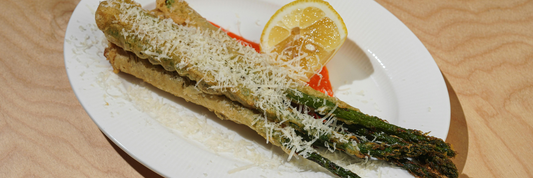Bamboo is making an appearance in the boardroom as well as the backyard. It used to be limited to backyard fences and panda snacks, but these days you can find it in nutrition bars and fine dining menus. However, how did this humble grass rise to prominence in the food industry? Join us as we delve into this wonderful material.
Things You Need to Know About Bamboo Fiber
What Is the Bamboo Fiber?
Bamboo fiber is a textile material made from the cellulose within bamboo plants. It's essentially a type of fabric, but with some unique properties. It can be obtained through methods of extraction then pinning and weaving.
What Is Bamboo Fiber Used for?
Bamboo fiber's versatility makes it a popular choice for numerous applications. Here are some of its key uses:
Clothing:
- Comfort and softness: Bamboo's inherent softness and breathability make it ideal for t-shirts, socks, underwear, pajamas, and loungewear.
- Odor-resistant: Its natural anti-bacterial properties help reduce odor-causing bacteria, making it perfect for activewear and sportswear.
- UV protection: Some bamboo fabrics offer natural UV protection, ideal for clothing worn outdoors.
Home textiles:
- Sustainable bed sheets and blankets: Bamboo's moisture-wicking and odor-resistant properties make it comfortable and hygienic for bedding.
- Luxurious towels: Bamboo towels are known for their exceptional softness and absorbency, enhancing your bathroom experience.
- Durable rugs and carpets: Processed bamboo fibers can be woven into beautiful and long-lasting rugs and carpets.
Food and beverage packaging:
- Cutlery and disposable tableware: Bamboo fiber plates, bowls, cups, and straws are eco-friendly alternatives to plastic, especially for on-the-go meals and snacks.
- Food wrappers and liners: Snack bags, cupcake liners, and even tea bags can be made from bamboo fiber, offering a breathable and compostable option.
- Coffee filters and tea bags: Sustainable and naturally antibacterial, bamboo fiber filters can enhance the taste of your brew.
- Beverage bottles and containers: Some companies are even experimenting with bamboo-based bottles for water and juices.
Other uses:
- Building materials: Bamboo can be processed into strong and durable boards used for flooring, walls, and furniture, offering a sustainable alternative to traditional materials.
- Stationery and paper products: Bamboo pulp can be used to create eco-friendly notebooks, paper towels, and other paper products.
- Medical applications: Bamboo fibers are explored in bandages, surgical gowns, and other medical products due to their anti-bacterial and hypoallergenic properties.
Is Bamboo a Good Material?
Bamboo fiber has some outstanding features, here are some main advantages:
- Sustainable: Bamboo grows rapidly, making it a renewable resource compared to slower-growing plants like wood.
- Biodegradable: Bamboo breaks down naturally, reducing waste and landfill burden.
- Antibacterial: Bamboo naturally has antibacterial properties, making it suitable for hygiene products and food packaging.
- Strong and durable: Bamboo can be surprisingly strong and resilient, making it suitable for various applications.
- Soft and comfortable: Bamboo fabric can be incredibly soft and breathable, making it ideal for clothing and bedding.
- Moisture-wicking: Bamboo fibers absorb and release moisture well, keeping you dry and comfortable.
- Hypoallergenic: Bamboo is generally gentle on sensitive skin, making it a good choice for people with allergies.
What Are the Disadvantages of Bamboo Fiber?
Beside of benefits, bamboo fiber still have some disadvantages, including:
- Cost: Bamboo products can be more expensive than their conventional counterparts, especially if they're not mass-produced.
- Durability (compared to some materials): While strong, bamboo isn't as durable as some materials like steel or concrete.
- Wrinkling: Bamboo fabric can wrinkle easily, requiring more care than some other materials.
- Not always readily available: Bamboo products may not be as readily available as other materials, depending on your location.
Is Bamboo Fiber Packaging Sustainable?
How Can Bamboo Fiber Replace Plastic Packaging?
Bamboo fiber has the potential to change the packaging industry by providing a more environmentally friendly and sustainable substitute for plastic. Here are some examples of its applications and food packaging types that it works well with:
- Versatility: Bamboo fiber can be molded and shaped into various forms, replacing plastic trays, cups, plates, bowls, cutlery, and even shrink wrap.
- Durability: While not as rigid as some plastics, bamboo fiber packaging can be surprisingly strong and suitable for a variety of food products.
- Biodegradability: Unlike plastic, bamboo fiber breaks down naturally within 6 months to a year, minimizing landfill waste and pollution.
- Composability: Some bamboo fiber packaging is even compostable, further reducing its environmental impact.
- Moisture and grease resistance: Certain types of bamboo fiber treatment can make it resistant to moisture and grease, making it suitable for food packaging.
Here is a table showing the difference between bamboo fiber vs plastic material across sustainable factors:
|
Factor |
Bamboo Fiber |
Plastic |
|
Resource |
Renewable (fast-growing grass) |
Non-renewable (fossil fuels) |
|
Biodegradability |
Decomposes naturally in 6-12 months |
Can take centuries, polluting landfills and oceans |
|
Compostability |
Composts readily, enriching soil |
Does not compost, creating microplastics |
|
Carbon Footprint |
Low carbon footprint due to fast growth and minimal processing |
High carbon footprint from extraction, transportation, and production |
|
Water Usage |
Requires less water than cotton or other traditional crops |
Uses large amounts of water during production and contributes to water pollution |
|
Chemical Usage |
Can be processed sustainably without harsh chemicals |
Often involves harmful chemicals and releases toxins during production and decomposition |
|
Health Impacts |
Naturally antibacterial and hypoallergenic |
Can leach harmful chemicals into food and water |
Due to the versatile applications and environmental benefits, bamboo fiber is completely a potential material to replace plastic material.

What Type of Food Packaging Can Be Made from Bamboo Fiber
Here are the common types of food packaging bamboo fiber can replace:
- Single-use plastics: Straws, cutlery, cups, plates, bowls, takeaway containers, food wraps, and coffee pods are all prime candidates for replacement with bamboo fiber alternatives.
- Flexible packaging: Pouches, bags, and liners for snacks, dried goods, and frozen food can be made from compostable bamboo-based films.
- Cartons and boxes: Cereal boxes, yogurt containers, and food trays can be replaced with sturdy and moisture-resistant bamboo fiber options.
What are the materials used in fiber-based packaging?
Is Bamboo Fiber Right for Your Business?
What Should You Consider Before Choosing Bamboo Fiber?
When considering choose bamboo fiber, here are things that your business should know:
- Durability: Choose products made with high-quality bamboo fibers for better strength and longevity.
- Care: Understand the specific care instructions for bamboo fiber products to ensure they last and maintain their quality.
- Cost: Bamboo fiber products may be slightly more expensive than their traditional counterparts, but the price gap is narrowing with increasing demand. Consider the long-term value of a sustainable product versus its initial cost.
- Transparency: Choose brands that provide clear information about their products' materials, processing methods, and sustainability practices.
- Certifications: Look for certifications like GRS (Global Recycling Standard) or BPI (Biodegradable Products Institute) to verify specific sustainability claims.
Bamboo Fiber Packaging from Kimecopak
At Kimecopak now, we offer to-go-box that includes bamboo fiber bowl. This new eco-friendly product that offers many benefits to environment and business, for example:
- Home compostable
- Versatile in use
- Microwaveable and freezer safe
- Durable than sugarcane
- Free from plastic, wax or gluten.
In addition, we offers customization service, with exclusive benefits for long-term partner including saving 5-7%, fixed price in 6 month, free storage and scheduled shipping. For more information, please contact us via email halo@kimecopk.ca or Kimecopak Facebook Fanpage.




